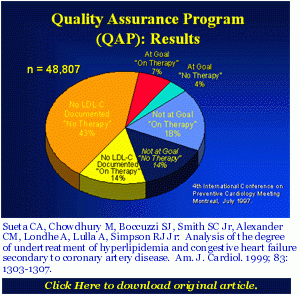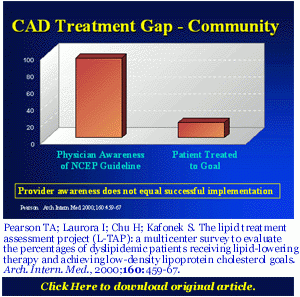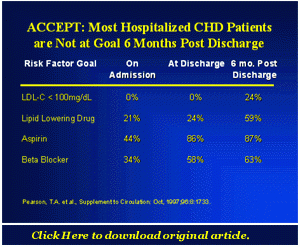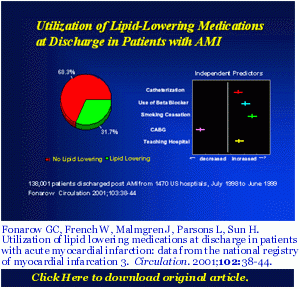Studies Showing Underutilization of Therapies for CAD Patients
QAP
The Quality Assurance Program (QAP) study was designed to assess adherence to NCEP, AHA, and AHCPR guidelines in outpatients with documented coronary artery disease and/or heart failure. The study included chart review of 58,980 patients from 140 medical practices. Patients had to have been seen at least twice in the prior 12 months and have the diagnosis confirmed on chart review. The mean age was 68 and 36% of patients were women.

This study showed that in 43% of patients LDL cholesterol had not been documented in the prior 12 months. Only 11% of the CAD patients were at goal with a LDL documented as being < 100 mg/dl. Patients who had an LDL documented were 4 times more likely to be treated with lipid lowering medication. This study clearly demonstrated a large CAD treatment gap in the outpatient setting. Since a documented LDL was a significant predictor of treatment, implementing a protocol to ensure that LDL levels are assessed in all CAD patients would be expected to improve treatment rates.
LTAP
The Lipid Treatment Assessment Project (L-TAP) assessed the percentage of patients receiving lipid lowering therapy who are achieving NCEP goals. A total of 4888 patients from 5 regions of the US were studied. Of these 30% of patients had established coronary heart disease. The physicians providing care for the patients were also surveyed to see if they were aware of the treatment goals. In the survey 95% of these primary care physicians indicated they were aware of the NCEP goals and believed they were evidence based. 61% of the physicians indicated they "most of the time" get their patients to goal. In actual practice, only 18% of the patients (n=1460) with CHD were at goal. Patients were twice as likely to be at goal if they were being treated with lipid lowering medication as opposed to diet alone. This study demonstrates the treatment gap is not due to a lack of awareness by physicians but a failure to have effective systems in place to implement treatment.

ACCEPT
This study showed that over 75% of patients hospitalized with CAD had not reached a LDL cholesterol < 100 mg/dl 6 months post discharge, despite the extra attention by virtual of being in this study. There was also under use of aspirin and beta blockers in this patient population. Note that not a single one of the more than 6000 patients in this study had a baseline LDL < 100 mg/dl

NRMI
The NRMI Registry Study assessed use of lipid lowing medication at time of discharge in patients with acute myocardial intfarction. This study included 138,001 patients from 1470 US hospitals from July of 1998 to June of 1999. This study showed that only 35% of acute MI patients were discharged on lipid lowering medications
Patients at teaching hospitals had a greater likelihood of receiving treatment. Patients discharged on the other evidence based therapies of aspirin, beta blockers and ACE inhibitors were more likely to also be discharged on lipid-lowering medication. Likewise, current smokers that were treated by physicians and nurses that provided smoking cessation counseling during hospitalization were more likely to be discharged on lipid-lowering medication. This indicates lipid-lowering medications utilization is impacted by physician education and the process of care in place within the hospital and could be favorably impacted by educational initiatives and quality improvement projects
